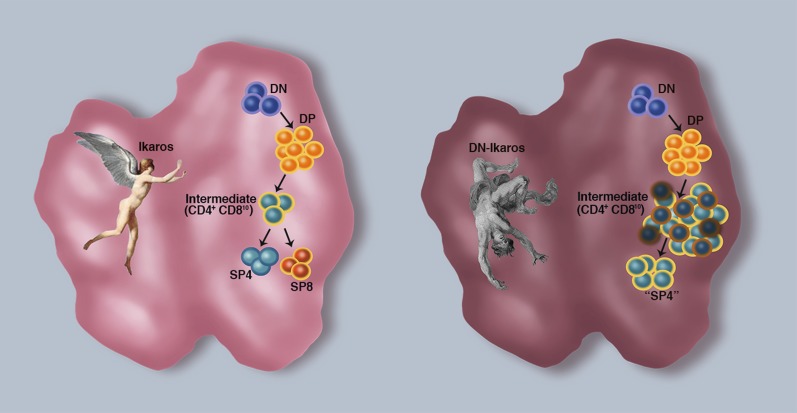Ikaros rescue of positively selected thymocytes. T-cell differentiation requires that hematopoietic progenitors migrate from the bone marrow into the thymus. Early progenitors express neither the CD4 nor the CD8 coreceptor and are therefore termed double-negative (DN) thymocytes. On commitment to the T-cell lineage, the developing thymocytes acquire CD4 and CD8 expression and are termed double-positive (DP) thymocytes. Those DP thymocytes that are signaled via their TCR become intermediate (CD4+CD8lo) cells that can then differentiate to mature single positive CD4 (SP4) or CD8 (SP8) thymocytes. Tinsley et al1 identify Ikaros as a critical factor in the survival and differentiation of these intermediate thymocytes to a mature SP fate (left thymus). Under conditions where a dominant negative Ikaros (DN-Ikaros) is expressed, suppressing the function of all Ikaros family members, there is a concomitant proliferation and apoptosis of these intermediate thymocytes, inhibiting further differentiation and driving the clonal expansion of these semimature cells. Ikaros in flight (left thymus) and in fall (right thymus) are from Charles Paul Landon’s painting of Dedalus and Icarus (1799; Musée des Beaux-Arts et de la Dentelle, Alençon, France) and Peter Paul Rubens’ painting of The fall of Icarus (Musées Royaux Des Beaux-Arts, Brussels, Belgium), respectively. Figure design by Sandrina Kinet, Institut de Génétique Moléculaire de Montpellier, France. Professional illustration by Marie Dauenheimer.

An official website of the United States government
Here's how you know
Official websites use .gov
A
.gov website belongs to an official
government organization in the United States.
Secure .gov websites use HTTPS
A lock (
) or https:// means you've safely
connected to the .gov website. Share sensitive
information only on official, secure websites.
